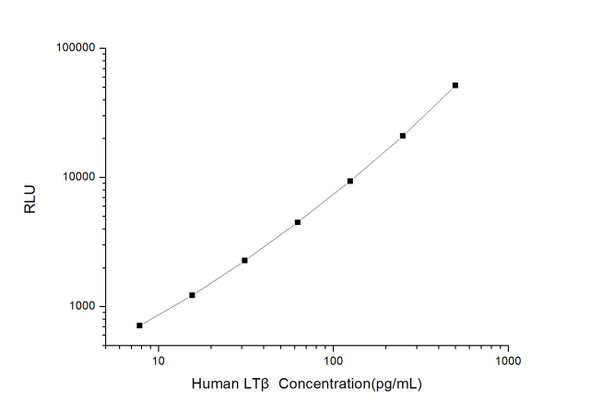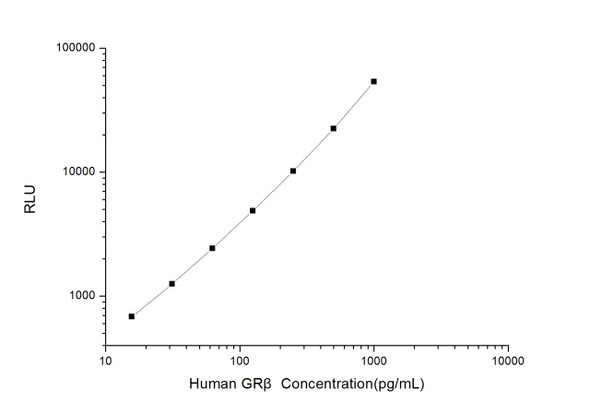Human Cell Death ELISA Kits
Human LT betaR (Lymphotoxin Beta Receptor) CLIA Kit (HUES00313)
- SKU:
- HUES00313
- Product Type:
- ELISA Kit
- ELISA Type:
- CLIA Kit
- Size:
- 96 Assays
- Sensitivity:
- 37.5pg/mL
- Range:
- 62.5-4000pg/mL
- ELISA Type:
- Sandwich
- Synonyms:
- LTBR, CD18, D12S370, LT-BETA-R, TNF-R-III, TNFCR, TNFR-RP, TNFR2-RP, TNFR3, TNFRSF3
- Reactivity:
- Human
- Sample Type:
- Serum, plasma and other biological fluids
- Research Area:
- Cell Death
Description
| Assay type: | Sandwich |
| Format: | 96T |
| Assay time: | 4.5h |
| Reactivity: | Human |
| Detection method: | Chemiluminescence |
| Detection range: | 62.50-4000 pg/mL |
| Sensitivity: | 37.50 pg/mL |
| Sample volume: | 100µL |
| Sample type: | Tissue homogenates,cell lysates and other biological fluids |
| Repeatability: | CV < 15% |
| Specificity: | This kit recognizes Human LT betaR in samples. No significant cross-reactivity or interference between Human LT betaR and analogues was observed. |
This kit uses Sandwich-CLIA as the method. The micro CLIA plate provided in this kit has been pre-coated with an antibody specific to Human LT betaR. Standards or samples are added to the appropriate micro CLIA plate wells and combined with the specific antibody. Then a biotinylated detection antibody specific for Human LT betaR and Avidin-Horseradish Peroxidase (HRP) conjugate are added to each micro plate well successively and incubated. Free components are washed away. The substrate solution is added to each well. Only those wells that contain Human LT betaR, biotinylated detection antibody and Avidin-HRP conjugate will appear fluorescence. The Relative light unit (RLU) value is measured spectrophotometrically by the Chemiluminescence immunoassay analyzer. The RLU value is positively associated with the concentration of Human LT betaR. The concentration of Human LT betaR in the samples can be calculated by comparing the RLU of the samples to the standard curve.
| UniProt Protein Function: | LTBR: Receptor for the heterotrimeric lymphotoxin containing LTA and LTB, and for TNFS14/LIGHT. Promotes apoptosis via TRAF3 and TRAF5. May play a role in the development of lymphoid organs. |
| UniProt Protein Details: | Protein type:Membrane protein, integral Chromosomal Location of Human Ortholog: 12p13 Cellular Component: integral to membrane Molecular Function:identical protein binding; protein binding; ubiquitin protein ligase binding Biological Process: positive regulation of I-kappaB kinase/NF-kappaB cascade; viral reproduction; apoptosis; positive regulation of JNK cascade; myeloid dendritic cell differentiation; signal transduction |
| NCBI Summary: | This gene encodes a member of the tumor necrosis factor receptor superfamily. The major ligands of this receptor include lymphotoxin alpha/beta and tumor necrosis factor ligand superfamily member 14. The encoded protein plays a role in signalling during the development of lymphoid and other organs, lipid metabolism, immune response, and programmed cell death. Activity of this receptor has also been linked to carcinogenesis. Alternatively spliced transcript variants encoding multiple isoforms have been observed. [provided by RefSeq, Aug 2012] |
| UniProt Code: | P36941 |
| NCBI GenInfo Identifier: | 549090 |
| NCBI Gene ID: | 4055 |
| NCBI Accession: | P36941. 1 |
| UniProt Secondary Accession: | P36941,B7Z1D2, D3DUR2, F5GXE7, |
| UniProt Related Accession: | P36941 |
| Molecular Weight: | 435 |
| NCBI Full Name: | Tumor necrosis factor receptor superfamily member 3 |
| NCBI Synonym Full Names: | lymphotoxin beta receptor (TNFR superfamily, member 3) |
| NCBI Official Symbol: | LTBR |
| NCBI Official Synonym Symbols: | CD18; TNFCR; TNFR3; D12S370; TNFR-RP; TNFRSF3; TNFR2-RP; LT-BETA-R; TNF-R-III |
| NCBI Protein Information: | tumor necrosis factor receptor superfamily member 3; lymphotoxin B receptor; tumor necrosis factor C receptor; tumor necrosis factor receptor type III; tumor necrosis factor receptor 2-related protein |
| UniProt Protein Name: | Tumor necrosis factor receptor superfamily member 3 |
| UniProt Synonym Protein Names: | Lymphotoxin-beta receptor; Tumor necrosis factor C receptor; Tumor necrosis factor receptor 2-related protein; Tumor necrosis factor receptor type III; TNF-RIII; TNFR-III |
| Protein Family: | Tumor necrosis factor receptor superfamily |
| UniProt Gene Name: | LTBR |
| UniProt Entry Name: | TNR3_HUMAN |
As the RLU values of the standard curve may vary according to the conditions of the actual assay performance (e. g. operator, pipetting technique, washing technique or temperature effects), the operator should establish a standard curve for each test. Typical standard curve and data is provided below for reference only.
| Concentration (pg/mL) | RLU | Average | Corrected |
| 4000 | 59044 59118 | 59081 | 59046 |
| 2000 | 26840 28878 | 27859 | 27824 |
| 1000 | 13703 13265 | 13484 | 13449 |
| 500 | 6404 6806 | 6605 | 6570 |
| 250 | 3274 3212 | 3243 | 3208 |
| 125 | 1615 1547 | 1581 | 1546 |
| 62.50 | 750 760 | 755 | 720 |
| 0 | 35 35 | 35 | -- |
Precision
Intra-assay Precision (Precision within an assay): 3 samples with low, mid range and high level Human LT betaR were tested 20 times on one plate, respectively.
Inter-assay Precision (Precision between assays): 3 samples with low, mid range and high level Human LT betaR were tested on 3 different plates, 20 replicates in each plate.
| Intra-assay Precision | Inter-assay Precision | |||||
| Sample | 1 | 2 | 3 | 1 | 2 | 3 |
| n | 20 | 20 | 20 | 20 | 20 | 20 |
| Mean (pg/mL) | 195.26 | 403.94 | 1376.58 | 195.96 | 386.93 | 1413.13 |
| Standard deviation | 21.09 | 36.19 | 89.62 | 17.17 | 30.53 | 153.47 |
| C V (%) | 10.80 | 8.96 | 6.51 | 8.76 | 7.89 | 10.86 |
Recovery
The recovery of Human LT betaR spiked at three different levels in samples throughout the range of the assay was evaluated in various matrices.
| Sample Type | Range (%) | Average Recovery (%) |
| Serum (n=5) | 85-96 | 91 |
| EDTA plasma (n=5) | 99-116 | 108 |
| Cell culture media (n=5) | 86-98 | 93 |
Linearity
Samples were spiked with high concentrations of Human LT betaR and diluted with Reference Standard & Sample Diluent to produce samples with values within the range of the assay.
| Serum (n=5) | EDTA plasma (n=5) | Cell culture media (n=5) | ||
| 1:2 | Range (%) | 86-97 | 91-107 | 90-103 |
| Average (%) | 91 | 99 | 95 | |
| 1:4 | Range (%) | 94-107 | 101-115 | 88-104 |
| Average (%) | 99 | 107 | 95 | |
| 1:8 | Range (%) | 99-113 | 99-111 | 93-106 |
| Average (%) | 105 | 105 | 99 | |
| 1:16 | Range (%) | 86-97 | 88-102 | 89-104 |
| Average (%) | 92 | 95 | 96 |
An unopened kit can be stored at 4°C for 1 month. If the kit is not used within 1 month, store the items separately according to the following conditions once the kit is received.
| Item | Specifications | Storage |
| Micro CLIA Plate(Dismountable) | 8 wells ×12 strips | -20°C, 6 months |
| Reference Standard | 2 vials | |
| Concentrated Biotinylated Detection Ab (100×) | 1 vial, 120 µL | |
| Concentrated HRP Conjugate (100×) | 1 vial, 120 µL | -20°C(shading light), 6 months |
| Reference Standard & Sample Diluent | 1 vial, 20 mL | 4°C, 6 months |
| Biotinylated Detection Ab Diluent | 1 vial, 14 mL | |
| HRP Conjugate Diluent | 1 vial, 14 mL | |
| Concentrated Wash Buffer (25×) | 1 vial, 30 mL | |
| Substrate Reagent A | 1 vial, 5 mL | 4°C (shading light) |
| Substrate Reagent B | 1 vial, 5 mL | 4°C (shading light) |
| Plate Sealer | 5 pieces | |
| Product Description | 1 copy | |
| Certificate of Analysis | 1 copy |
- Set standard, test sample and control (zero) wells on the pre-coated plate and record theirpositions. It is recommended to measure each standard and sample in duplicate. Note: addall solutions to the bottom of the plate wells while avoiding contact with the well walls. Ensuresolutions do not foam when adding to the wells.
- Aliquot 100µl of standard solutions into the standard wells.
- Add 100µl of Sample / Standard dilution buffer into the control (zero) well.
- Add 100µl of properly diluted sample (serum, plasma, tissue homogenates and otherbiological fluids. ) into test sample wells.
- Cover the plate with the sealer provided in the kit and incubate for 90 min at 37°C.
- Aspirate the liquid from each well, do not wash. Immediately add 100µL of BiotinylatedDetection Ab working solution to each well. Cover the plate with a plate seal and gently mix. Incubate for 1 hour at 37°C.
- Aspirate or decant the solution from the plate and add 350µL of wash buffer to each welland incubate for 1-2 minutes at room temperature. Aspirate the solution from each well andclap the plate on absorbent filter paper to dry. Repeat this process 3 times. Note: a microplatewasher can be used in this step and other wash steps.
- Add 100µL of HRP Conjugate working solution to each well. Cover with a plate seal andincubate for 30 min at 37°C.
- Aspirate or decant the solution from each well. Repeat the wash process for five times asconducted in step 7.
- Add 100µL of Substrate mixture solution to each well. Cover with a new plate seal andincubate for no more than 5 min at 37°C. Protect the plate from light.
- Determine the RLU value of each well immediately.






